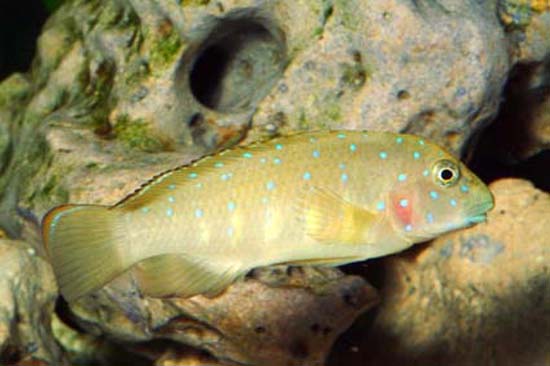| Cichlidae (Cichlids), subfamily: Pseudocrenilabrinae |
| 9 cm TL (male/unsexed) |
|
benthopelagic; freshwater; pH range: 8 - 9; dH range: 9 - 19, |
| Africa: endemic to Lake Tanganyika, occurs in the southern part of the Lake, from Kipili (Tanzania) to Moliro (Democratic Republic of the Congo) (Ref. 46829). |
|
Dorsal spines (total): 23-24; Dorsal soft rays (total): 4-5; Anal spines: 3-3; Anal soft rays: 6-7. Diagnosis: Eretmodus cyanostictus is characterized by a terminal mouth and a number of bright blue spots on the head and upper half of the body (Ref. 92306). About 5 light bars are present on the side of the body but evident only on the lower half of the body and none crossing the posterior en of the body or caudal peduncle (Ref. 92306). |
| Occurs in rocky areas (Ref. 53528). Adults occur in the turbulent, highly oxygenated shallow waters of the surf zone; found in the shallows of a gradually sloping rocky coast where some sand is found between the rocks; solitary and to some extent, territorial; heavy body and small swim bladder result in negative buoyancy (Ref. 6770). Feeds on algae which are scraped from the rocks (Ref. 6770, 46829). Both parents brood their young in the mouth (Ref. 52921, 86760). |
|
Near Threatened (NT); Date assessed: 31 January 2006 Ref. (130435)
|
| harmless |
|
Source and more info: www.fishbase.org. For personal, classroom, and other internal use only. Not for publication.

